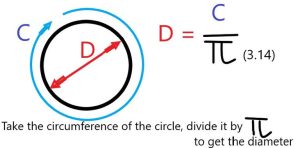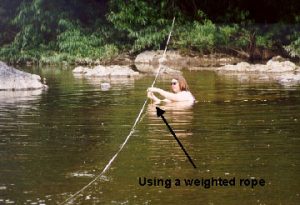0.1 Order of Operations
Applications
When you measure the size of a tree, you often measure its circumference and use that to find the diameter. The circumference is measured outside of the bark, but to calculate the volume of lumber, you need to know the diameter of the tree inside the bark. So, we use the circumference to find the diameter outside of the bark and then subtract the thickness of the bark.

This is all pretty straightforward, but the calculations will only get you the correct diameter inside the bark if you input them in the right order!
Take a look at the following example:
Diameter inside bark = Circumference / pi - 2 * average bark thickness
Circumference = 24 inches
Pi = 3.14
Average bark thickness = 1.5 inches
Diameter inside bark = 24/3.14-2*1.5
Is the diameter inside bark 4.64 inches? Why or why not?

We'll begin with a look at order of operations. In many situations in life, the order in which we perform certain actions is important. For example, if you are putting on your shoes and socks, you need to put a sock on your foot before you put a shoe on that foot. However, if you put on your left sock first, it doesn't really matter whether the next thing you put on is your left shoe or your right sock, as long as you don't try putting on your right shoe next. A multi-step math calculation can be the same way; you might have some steps that need to happen in a specific sequence, but there may be some steps that you can do in whatever order you prefer.
Evaluating an Expression
To evaluate an expression means to simplify it and find its value.
Practice Exercises
- Evaluate by performing the addition first: [latex]12–2+3[/latex]
- Evaluate by performing the subtraction first: [latex]12–2+3[/latex]
When we evaluate an expression, we want to have a single correct answer. It isn’t very helpful for the answer to be “maybe 7, or maybe 13”. Mathematicians have decided on an order of operations, which tells us which steps should be done before other steps. You can think of them as the rules of the road.
Order of Operations: PEMDAS
P: Work inside of parentheses or grouping symbols, following the order PEMDAS as necessary inside the grouping symbols.
E: Evaluate exponents.
MD: Perform multiplications and divisions from left to right.
AS: Perform additions and subtractions from left to right.
Practice Exercises
Evaluate each expression.
- [latex]12–(2+3)[/latex]
- [latex]12–2+3[/latex]
Based on Exercises 3 & 4, we can see that Exercise 1 told us to use the wrong order of operations. If there are no parentheses, we must evaluate [latex]12–2+3[/latex] by first performing the subtraction and then performing the addition.
Before we move on, you should be aware that there are a handful of ways to show multiplication. All of the following represent [latex]3\times4[/latex]:
[latex]3\cdot4[/latex] [latex]3*4[/latex] [latex]3(4)[/latex] [latex](3)4[/latex] [latex](3)(4)[/latex]
In this textbook, you will most often see the dot, like [latex]3\cdot4[/latex], or parentheses directly next to a number, like [latex]3(4)[/latex]. We tend to avoid using the [latex]3\times4[/latex] symbol because it can be mistaken for the letter x.
Practice Exercises
Evaluate each expression.
- [latex]12\div(3\cdot2)[/latex]
- [latex]12\div3\cdot2[/latex]
- [latex]5(1+3)–2[/latex]
- [latex]5(1)+(3–2)[/latex]
Exponents
An exponent indicates repeated multiplication. For example, [latex]6^2=6\cdot6=36[/latex] and[latex]4^3=4\cdot4\cdot4=64[/latex]. The exponent tells us how many factors of the base are being multiplied together.
Practice Exercises
Evaluate each expression.
- [latex]3^2+4^2[/latex]
- [latex](3 + 4)^2[/latex]
- [latex](7+3)(7–5)^3[/latex]
- [latex]7+3(7–5)^3[/latex]
Grouping Symbols
In the next set of exercises, the only differences are the parentheses, but every exercise has a different answer.
Practice Exercises
Evaluate each expression.
- [latex]39–7\cdot2+3[/latex]
- [latex](39–7)\cdot2+3[/latex]
- [latex]39–(7\cdot2+3)[/latex]
- [latex]39–7\cdot(2+3)[/latex]
- [latex](39–7)\cdot(2+3)[/latex]
It is possible to have grouping symbols nested within grouping symbols; for example, [latex]7+(5^2-(3(17-12\div4)+2\cdot5)\div4)[/latex].
To make it somewhat easier to match up the pairs of left and right parentheses, we can use square brackets instead: [latex]7+(5^2-[3(17-12\div4)+2\cdot5]\div4)[/latex].
Practice Exercises
Simplify the expression.
- [latex]7+(5^2-[3(17-12\div4)+2\cdot5]\div4)[/latex]
A fraction bar is another grouping symbol; it tells us to perform all of the steps on the top and separately perform all of the steps down below. The final step is to divide the top number by the bottom number.
Your Calculator and Order of Operations
In general, today's calculators take order of operations into account. So, if you enter an expression into a calculator the way you read it, the calculator should respond with the correct answer.One exception is common however! When your expression includes a fraction bar, you'll need to use parentheses to group the numerator separately from the denominator in your calculator.
Try the following in your calculator to see the difference!
A) [latex]\frac{4+5*3}{10-2}[/latex]
B) (4+5*3)/(10-2)
Practice Exercises
Evaluate each expression.
- [latex]\frac{15-1}{6+1}[/latex]
- [latex]\frac{(7+2)\cdot4}{18\div(3+3)}[/latex]
- [latex]\frac{5\cdot4^2}{2}[/latex]
- [latex]\frac{(5\cdot4)^2}{2}[/latex]
- [latex]\frac{(5 – 1)^2}{2+6}[/latex]
- [latex](5 – 1)^2\div2+6[/latex]
We will look at formulas in a later module, but let's finish by translating from words to a mathematical expression.
Practice Exercises

- You can find the approximate Fahrenheit temperature by doubling the Celsius temperature and adding[latex]30[/latex]. If the temperature is [latex]9°C[/latex], what is the approximate Fahrenheit temperature? Write an expression and evaluate it.
- You can find the approximate Celsius temperature by subtracting [latex]30[/latex] from the Fahrenheit temperature and then dividing by [latex]2[/latex]. If the temperature is [latex]72°F[/latex], what is the approximate Celsius temperature? Write an expression and evaluate it.
Applications
It's not uncommon to need the width of a river as part of a habitat assessment for aquatic species. Does that mean we always need to get to the other side of the river?

Sine, Cosine, and Tangent are ratios that allow us to calculate distances across impassible barriers. This is useful math in areas with alligators, swift currents, piranha, canyons, cactus, etc.
Objectives
When you've completed this chapter, you'll be comfortable with the following calculations:
- Finding the sine, cosine and tangent for an angle using the ratio of sides of the triangle, or a measurement in degrees.
- Finding an angle's measurement in degrees given the sine, cosine or tangent.
- Using the measurement of one side of a right triangle and the measurement of an angle to find the other sides and angles using sine, cosine or tangent.

